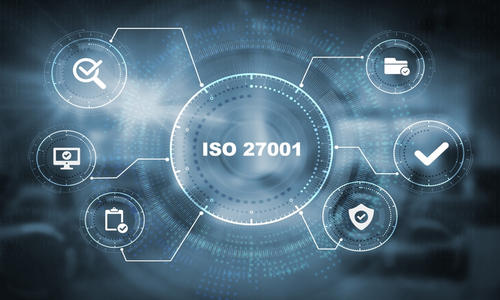Jump ahead to
What is an Information Security Management System?
Information Security is integral to any active organization, and as businesses around the world enact a greater network-based presence while facing a growing number of threats to their data, cybersecurity efforts must be handled with greater care and reliability than ever before. This is accomplished by an information security management system (ISMS), which assists organizations in managing the security of their information assets, such as financial information, intellectual property, and employee details or information entrusted to them by customers or third parties.
Information Security Management System
An Information Security Management System (ISMS) is a structured and systematic approach to managing company information. It provides businesses with a framework to manage information security and other IT-related risks, with wide-ranging controls to keep data secure from diverse security threats. An ISMS uses a risk management process that comprises organizational structures, people, policies, processes, and IT systems. An organization’s objectives determine ISMS Implementation, the size and structure of security requirements, and the procedures employed.
In short, it is a centrally managed framework for keeping an organization’s information safe. A set of policies, procedures, technical and physical controls to protect the confidentiality, availability, and integrity of information. It is either applied to the entire organization or only a specific area where the information it seeks to protect is segmented (the scope). It includes not only technical controls but also controls to treat additional, more common risks related to people, resources, assets and processes.
A global increase in data breaches has caused heightened information security concerns across all industries. Considering the significant financial and legal damages caused by breaches, all businesses with valuable information should consider implementing an information security management system.
An ISMS is often developed by a team established by IT stakeholders, comprising board members, managers, and IT staff. The team is tasked with designing, implementing, and maintaining a set of policies that comply with ISO 27001, the international standard for information security management systems. A compliant ISMS should become an integral part of your company’s culture that functions to maintain strong information security across the organization.
ISO 27001 and Information Security Management:
ISO 27001 is a category of international standards developed by ISO and the International Electro technical Commission (IEC). It outlines the criteria that businesses can follow to maintain the security of their information assets. They allow businesses of all sizes and in all industries to manage the protection of assets including financial data, intellectual property, employee information, and information provided by third parties.
The company can gain the following advantages from ISO 27001:
Ensure the security of all types of data, including digital, cloud, and paper-based information.
- Boost defenses against cyberattacks
- Provide a centrally controlled architecture that protects all data in one location.
- Provide organization-wide protection, including against threats and dangers associated with technology.
- Adapt to changing security threats
- Reduce your spending on defense technology that isn’t effective.
What are the three principles of ISO 27001?
The basic goal of ISO 27001 and an Information Security Management System is to protect three aspects of information:
Confidentiality: The confidentiality of information means measures should be taken to protect it from unauthorized access. Information access rights are only granted to authorized individuals. Access control lists, file permissions, and volume and file encryption are all methods of managing confidentiality.
Integrity: Data integrity is a crucial component of the information security triangle that protects against unauthorized changes or deletions to data. Moreover, it ensures that the data is not tampered with in any manner, whether by error or intentional action. This includes making sure that any unauthorized additions or deletions to the data may be undone.
Availability: The information must always be available to authorized persons whenever it is needed. Sabotage, faulty hardware, network failure, and power outages are a few information security risks to availability.
Benefits of ISMS:
- Provides a structured system of managing information security in an organization. A clear chain of data handling provides a monitoring and reporting model for management review.
- Provides an independent appraisal of your organization’s conformity to the best practices recommended by ISMS experts.
- Provides evidence and assurance that your organization has complied with international standards.
- Enhances information security governance within your organization.
- Enhances your organization’s reputation and global standing.
- It provides a common purpose with a common set of goals and a structured system for protecting organizational data.
- Establishes a complete IT Security Management Framework that enables your team to ensure information security compliance to prevent any risks.
- It helps manage information in all its forms, including digital, paper-based, intellectual property, company secrets, data on devices and in the Cloud, hard copies, and personal information.
- It helps the company defend itself from technology-based risks and other, more common threats such as poorly informed staff or ineffective procedures.
- It reduces costs spent on indiscriminately adding layers of additional technology that might not work due to the risk assessment and analysis approach.
- It constantly adapts to changes both in the environment and inside the organization to reduce the threat of continually evolving risks.
- It focuses on the integrity and availability of data as well as confidentiality.
- It enables businesses to be significantly more resilient to cyber-attacks.
Conclusion
ISMS aims to actively decrease the impact of a security breach in order to reduce risk and maintain business continuity. The objective of an ISMS is to achieve the appropriate degree of information security for a company, not necessarily to maximize information security. Professionals who are interested in learning more about ISO 27001 can enroll in the ISO 27001 Lead Implementer Training. Candidates may learn how to apply ISO 27001 standards in an enterprise with the help of training. The ISO 27001 Lead Implementer Training Certification is provided by Unichrone in both classrooms and live online classroom environments. ISO 27001 Lead Implementer Training is available across the world.



